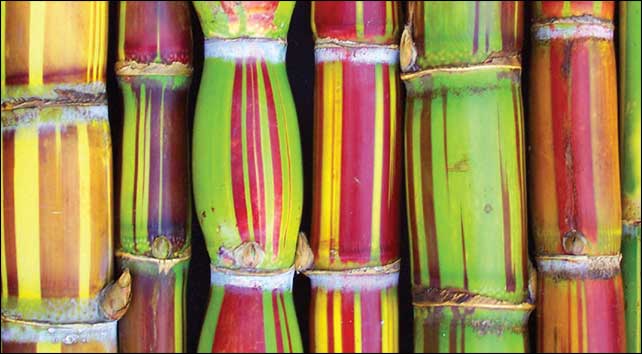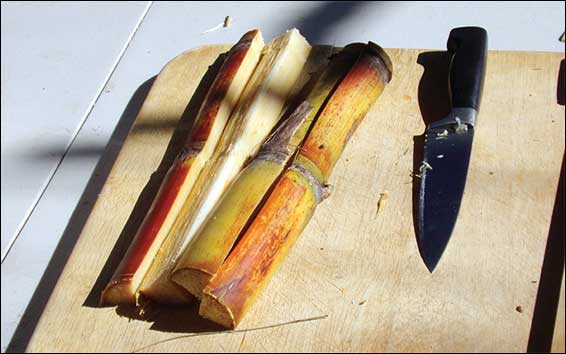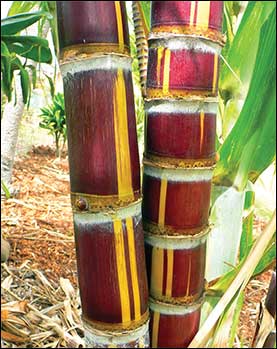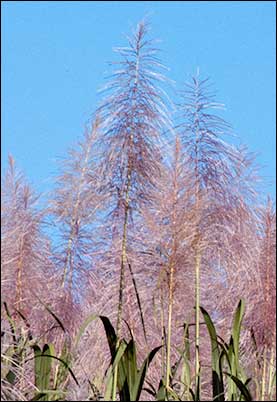Kō: A Spoon Full of Sugar

by Aaron Guerrero,
Garden Maintenance Manager
The beloved canoe plants were held in high regard to the ancient people of Hawai’i and all over the Pacific islands. The essential uses that these plants provided helped ensure the survival of many as they voyaged the Pacific and settled on new land. The traditions of these plants are still present today as it is held in the hearts and minds of a few practitioners, but only one has had a global impact on our modern society.

Sugar that we know of today mostly comes from a cultivated species of grass known as Saccharum officinarum “noble canes.” The genetics of sugar cane are believed to be highly complex and are attributed to the domestication and crossing of two wild species, one of which is said to be native to Papua New Guinea in Melanesia. The global dispersal of this crop goes unrivaled. It is the crop that gave birth to industrialized agriculture as it spread through Asia, Europe, Africa, South America, North America, and eventually to Hawai‘i. Crystallized sugar was the product of this new age industry and fueled the push for maximizing profits. It is consumed in mass amounts everyday by people all over the world. Although sugar is a vital physiological compound for our bodies, excessive amounts may lead to a metabolic disorder known as diabetes. It is a condition where the body is not efficient at utilizing blood sugar for energy. About 130 million people live with diabetes or are prediabetic in the U.S.
The pairing of the sugar cane industry and Hawai‘i are well known throughout our islands. Frankly, many aspects of our local culture would not be here if not for the sugar industry due to the importation of labor, but historically, these islands share another connection to this plant.
Sugar cane or kō first made its way to Hawai‘i on canoes. Kō is one of the valued canoe plants introduced here more than a thousand years ago by the ancient people who settled these islands. Ancient Hawaiians were masters at their crafts, including agriculture. With time and observation, they were able to develop practices that ensured the survival of many food crops by establishing a genuine harmony between nature, the farmer, and the ahupua’a. Kō was planted among other crops in an efficient manner and their intimate relationship with their crops helped create many different varieties. This can be found with other cultivated crops such as ‘uala, kalo, mai‘a, and ‘awa.


The technique that was shared by ancient cultures around the Pacific to extract the sugar water was by simply chewing the stalk and disposing of the fibers. It proved to be an effective way to keep teeth clean and plaque free as well as helped strengthen muscles in the jaw. Although it served as a nice sweet refreshing treat for everyday life, old texts and mo‘olelo show that the main purpose of kō was to sweeten bitter tasting medicines or served as part of the medicines as well. It was also used for ceremonial and religious offerings, as well as in hana aloha, love magic. It is well documented that certain varieties of kō were reserved for these specific uses.
Researchers are beginning to shed light on the health benefits of raw sugar cane water.
There are now modern scientific data that support the notion that raw sugar cane water can be anti-inflammatory, relieves pain, lowers blood glucose levels, improves urination, and may protect the liver. There are also claims that it may be slightly better for exercise recovery in athletes when compared to sports drinks and plain water.
Maui Nui Botanical Gardens continues to work closely with a few select gardens and research centers around the state in helping to sort out and cultivate known Hawaiian heirloom varieties. Most of this research is led by Noa Kekuewa Lincoln, who released a book about his work in striving to map out the genetics of these varieties and giving kō farmers and practitioners a resource and database on identifying sugar cane varieties, including introduced and hybrids. It will always be an important value of our Garden to preserve and propagate Hawaiian cultivars because evidently, they are the product of many generations of ancient people’s intimate relationship with their crops…He Keiki Aloha Na Mea Kanu.
Location
The Garden is located at 150 Kanaloa Avenue in Kahului, Maui, right across from the War Memorial Stadium.
(808) 249-2798
Hours of Operation
Tuesday through Saturday,
8:00 a.m. – 4:00 p.m.
Closed occasionally for inclement weather and Hawaii State Holidays.
Admission
Members: Free
General: $10
Keiki Under 12: Free
Kama'aina: Free
(with Hawai'i ID)

